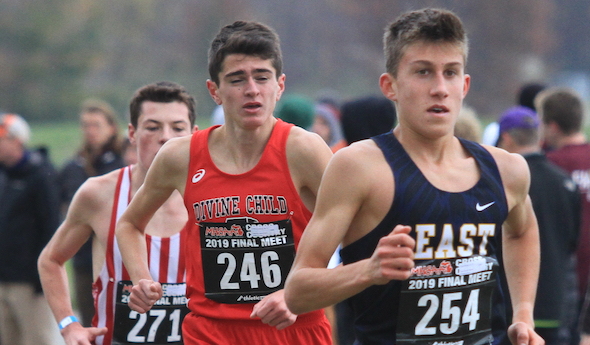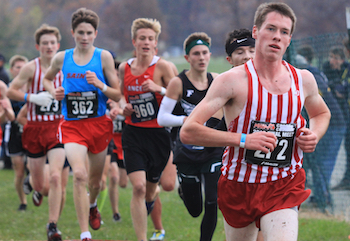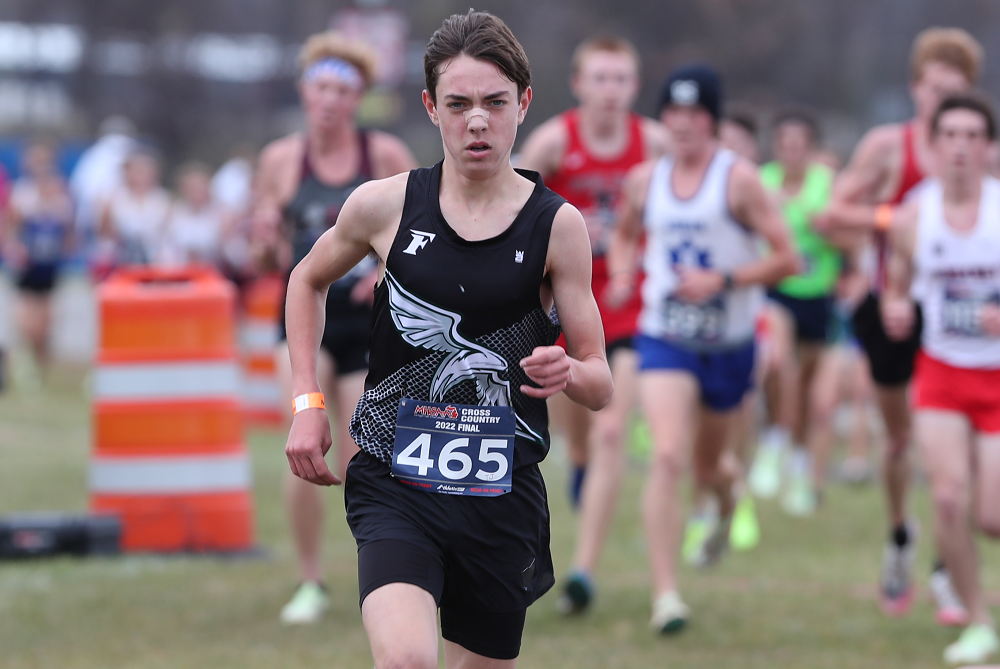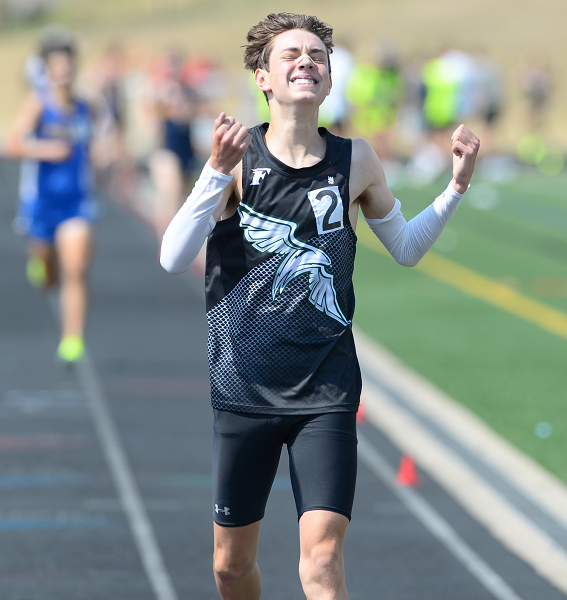
EGR's Bishop, Fremont Earn Places with Elite
November 2, 2019
Second Half reports
BROOKLYN – Evan Bishop of East Grand Rapids had already established himself as one of the elite runners in a state known for producing great distance talent.
But while Bishop had credentials and a reputation that stacked up favorably with anyone’s in Michigan, he didn’t have an individual MHSAA championship on his resume.
That changed Saturday when he won the Lower Peninsula Division 2 meet with a time of 15:12.6.
In the process, he defeated one of the runners who deprived him of getting an MHSAA championship sooner, Dearborn Divine Child senior Anthony Hancock. Hancock was second in 15:18.2.
Bishop was second in cross country last year to Otsego senior Alex Comerford. In the spring, he took second to Hancock in the 3,200-meter run with a time of 9:08.03. In between those performances, Bishop earned All-America honors at the Foot Locker National Cross Country Championship in San Diego by placing ninth.
“Last year I made it to some of the national meets, and it was a big surprise,” Bishop said. “This year coming back, it’s like I know I’m at that level. I’m just trying to improve upon last year. I’ve checked those boxes. I made it to nationals, I was second three times last year. Honestly, this season, my biggest goal was winning this race. I couldn’t be happier.”
Bishop emerged victorious in a race that featured four runners who have broken 15 minutes. It was unlikely anyone would break that barrier Saturday on a muddy course and in windy conditions.
 “If the weather would’ve been a little bit better, the extreme level of the field this year is just amazing,” said Bishop, who won 10 of 11 meets and didn’t lose to a runner from Michigan this fall. “Times could have been really fast.”
“If the weather would’ve been a little bit better, the extreme level of the field this year is just amazing,” said Bishop, who won 10 of 11 meets and didn’t lose to a runner from Michigan this fall. “Times could have been really fast.”
When Hancock crossed the line, he immediately turned around to watch the battle for third place. He had a vested interest in the outcome because his twin brother, Michael, was battling Fremont’s Nathan Walker. Michael Hancock edged Walker by two tenths of a second with a time of 15:23.7.
“Going into it, we were hoping for one and two,” Anthony Hancock said. “It didn’t end up happening, but we did end up going two and three. I knew Michael and Walker would be battling it out. I had a feeling Michael would beat him, because his kick is so strong. I turned around, and I saw him pass him.”
Walker did come away with the satisfaction of leading his team to a championship, as Fremont dominated the field with a 68-point performance. Otsego was second with 176. It was Fremont’s eighth MHSAA championship, the last coming in 2015.
Fremont put its five scoring runners in the top 28 in the team race. Conor Somers was sixth in 16:01.5, Adam Ward 14th in 16:23.0, Ben Paige 16th in 16:23.9 and Mikko Vesma 28th in 16:40.3.
PHOTOS: (Top) East Grand Rapids’ Evan Bishop pulls a few steps ahead of Dearborn Divine Child’s Anthony Hancock and Fremont’s Nathan Walker. (Middle) Fremont’s Adam Ward (272) leads another pack that includes teammate Joshua Zerfas (273). (Photos by Matt Yacoub/RunMichigan.com.)

Freeland's Hansen Not Focused on Joining All-Time Greats - But On His Way
By
Paul Costanzo
Special for MHSAA.com
September 29, 2023
The goal written on Matt Kaczor’s Post-It Note was sub-15 minutes, 15 seconds. That’s what the Freeland cross country coach was hoping for from star runner TJ Hansen during his junior season.
 Kaczor tore it up after seeing Hansen run a single race this fall.
Kaczor tore it up after seeing Hansen run a single race this fall.
“Knowing what he did over the summer and where he was at, seeing what his 1,600 (meter) and his mile got down to, I had a feeling he could get under 15:30 quickly,” Kaczor said. “After the first race, I looked at my assistant and was like, ‘I’ve gotta rip up that Post-It Note. I don’t think our goal is on the level of where he’s at right now.’ At first, it was break 15:15. Once I saw him race at the Under the Lights (on Aug. 18 at St. Johns), I was like, ‘Yeah, he’s going sub 15.’”
Hansen ran 15:39.6 in that first race, and on Sept. 7, in Shepherd, he ran 15:13.9 to meet the goal written on the now-shredded Post-It Note.
This past Saturday, he ran 15:03.7 at the Cadillac Veterans Serving Veterans Invitational. It’s the fastest time recorded in Michigan this year, and a signal that Kaczor might be filling out a new Post-It Note before the season is out.
“The sub-15 barrier, that’s been something on my mind for a while,” Hansen said. “Now that I’m edging closer and closer to that, it’s been exciting. With how heavy my training has been, I wouldn’t expect (to have run this fast this early). Being able to run the times I am really paints the picture for what’s ahead.”
Hansen came into the season already regarded as one of the elite distance runners in the state. He won the 3,200 meters at the MHSAA Lower Peninsula Division 2 Track & Field Finals this past spring. He’s also finished all-state (12th and fifth, respectively) the past two seasons at the LPD2 Cross Country Finals.
His current trajectory, however, would put his name near some of the state’s all-time greats. But that’s not something Hansen is focusing on.
“I really don’t like to compare myself to others,” he said. “I don’t focus on that. I try to be the best TJ Hansen that I can be. The best version of myself.”
Focusing on himself is almost necessary for Hansen, as he’s spending a lot of time during his races running by himself.
At each of the big events Freeland has run in this season, Hansen has finished at least 20 seconds ahead of his nearest competitor. That includes all divisions of the Duane Raffin Festival of Races in Holly.
In Cadillac, where Hansen ran his current best time, he was a full minute ahead of the rest of the field.
 “He’s just a special athlete,” Kaczor said. “I can’t see Freeland having someone like this in a while. He’s a generational talent. What’s crazy is, I had the school record when he was a freshman. He and Braden (Honsinger) broke it last year. But TJ has now dropped that school record (set in 1998) by almost a minute.”
“He’s just a special athlete,” Kaczor said. “I can’t see Freeland having someone like this in a while. He’s a generational talent. What’s crazy is, I had the school record when he was a freshman. He and Braden (Honsinger) broke it last year. But TJ has now dropped that school record (set in 1998) by almost a minute.”
Hansen’s achievements have already put him on a path to run at the next level, which is something of a family tradition.
His older sisters Peyton and Kiera are track & field athletes at Wayne State and Eastern Michigan, respectively. Their parents, Tim and Pam, were track & field stars at Central Michigan.
TJ has drawn the attention of coaches around the country, including from Michigan, Michigan State, Wisconsin, Tennessee and Colorado.
Having family members who know the process is a help for Hansen, and he said they’ve all been good about allowing him to choose his own path, whatever that may be.
“He’s from a good family that knows how to work and knows how to get things done,” Kaczor said. “He knows that if he puts in the work, he’s going to be at a good spot.”
While Hansen admits it can be a bit overwhelming, he’s using it as motivation to run faster and continue to put his name out there.
Also serving as motivation is 2022 Division 2 champion Connell Alford of Chelsea. Alford is among the elite group of runners in Michigan who have broken the 15-minute mark, doing it twice a year ago.
He currently has the state’s second-best time behind Hansen’s this year, running 15:09.1 at the MSU Invitational on Sept. 15.
“Whenever I see him drop a time, my main goal is to run faster,” Hansen said. “Whenever I see him run a good time, that motivates me to work hard.”
The two won’t see each other until the MHSAA Finals on Nov. 4 at Michigan International Speedway. It’s an opportunity Hansen is excited for, as it’s a chance to race and be pushed toward the lofty goals he’s set for himself. Kaczor is excited about it, too, even if it might mean having to replenish his supply of Post-Its.
“We don’t talk about winning the state title; we talk about making sure that we have great races on those days,” Kaczor said. “We can’t control how somebody else runs. It’s a matter of can we, if the weather is right and the course is in good condition, can we be one of the few guys that has run in the 14s on that course? That’s the goal. Put yourself in some great categories with those upper echelons and the greats of all-time.”
 Paul Costanzo served as a sportswriter at The Port Huron Times Herald from 2006-15, including three years as lead sportswriter, and prior to that as sports editor at the Hillsdale Daily News from 2005-06. He can be reached at [email protected] with story ideas for Genesee, Lapeer, St. Clair, Sanilac, Huron, Tuscola, Saginaw, Bay, Arenac, Midland and Gladwin counties.
Paul Costanzo served as a sportswriter at The Port Huron Times Herald from 2006-15, including three years as lead sportswriter, and prior to that as sports editor at the Hillsdale Daily News from 2005-06. He can be reached at [email protected] with story ideas for Genesee, Lapeer, St. Clair, Sanilac, Huron, Tuscola, Saginaw, Bay, Arenac, Midland and Gladwin counties.
PHOTOS (Top) Freeland's TJ Hansen leads a pack during last season's LPD2 Final at Michigan International Speedway. (Middle) Hansen enjoys a moment of exhilaration after winning the 3,200 this spring at the LPD2 Finals at Ada Forest Hills Eastern. (Top photo by Carter Sherline/Run Michigan; middle photo by Dave McCauley/Run Michigan.)

